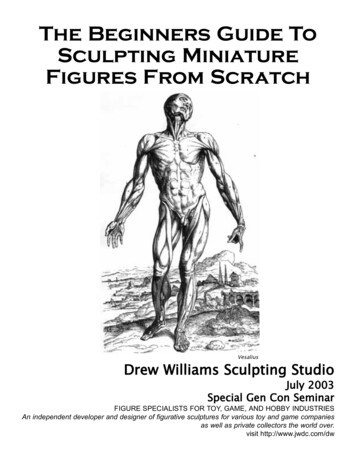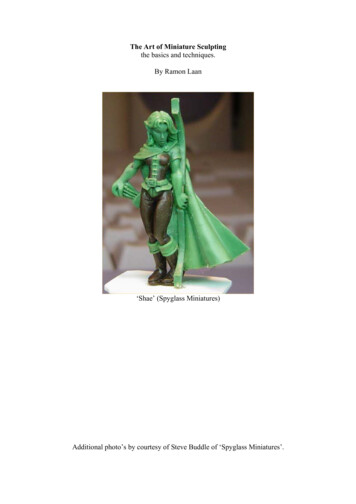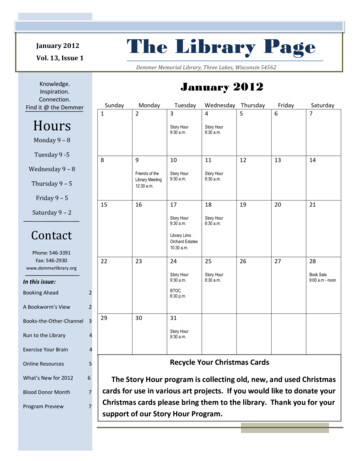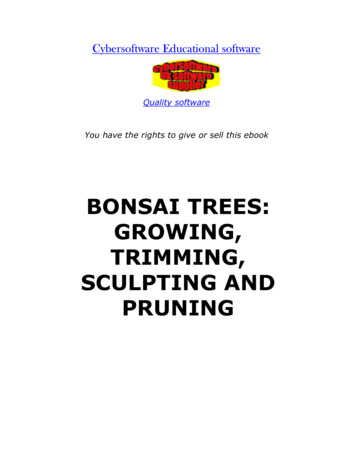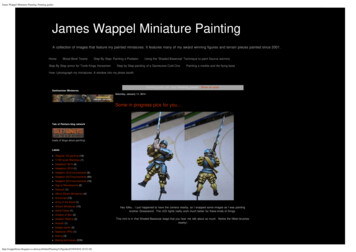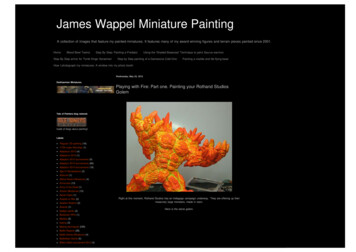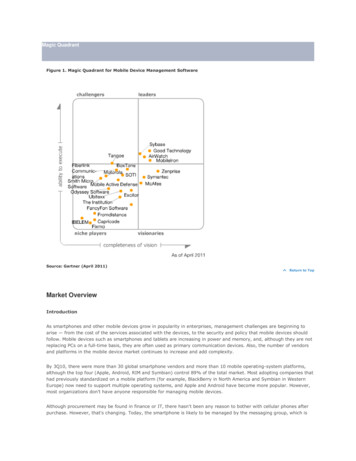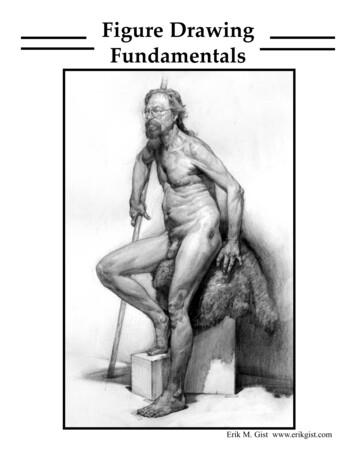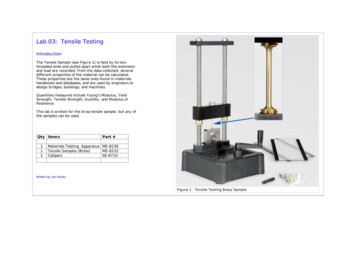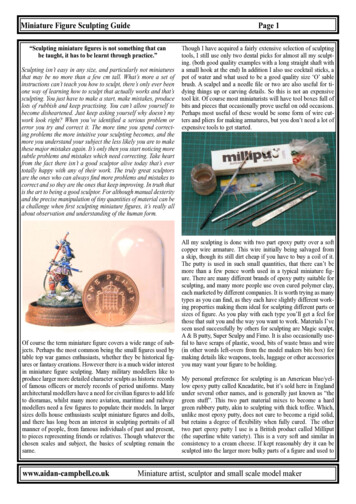
Transcription
Miniature Figure Sculpting GuidePage 1“Sculpting miniature figures is not something that canbe taught, it has to be learnt through practice.”Sculpting isn’t easy in any size, and particularly not miniaturesthat may be no more than a few cm tall. What’s more a set ofinstructions can’t teach you how to sculpt, there’s only ever beenone way of learning how to sculpt that actually works and that’ssculpting. You just have to make a start, make mistakes, producelots of rubbish and keep practising. You can’t allow yourself tobecome disheartened. Just keep asking yourself why doesn’t mywork look right? When you’ve identified a serious problem orerror you try and correct it. The more time you spend correcting problems the more intuitive your sculpting becomes, and themore you understand your subject the less likely you are to makethese major mistakes again. It’s only then you start noticing moresubtle problems and mistakes which need correcting. Take heartfrom the fact there isn’t a good sculptor alive today that’s evertotally happy with any of their work. The truly great sculptorsare the ones who can always find more problems and mistakes tocorrect and so they are the ones that keep improving. In truth thatis the art to being a good sculptor. For although manual dexterityand the precise manipulation of tiny quantities of material can bea challenge when first sculpting miniature figures, it’s really allabout observation and understanding of the human form.Of course the term miniature figure covers a wide range of subjects. Perhaps the most common being the small figures used bytable top war games enthusiasts, whether they be historical figures or fantasy creations. However there is a much wider interestin miniature figure sculpting. Many military modellers like toproduce larger more detailed character sculpts as historic recordsof famous officers or merely records of period uniforms. Manyarchitectural modellers have a need for civilian figures to add lifeto dioramas, whilst many more aviation, maritime and railwaymodellers need a few figures to populate their models. In largersizes dolls house enthusiasts sculpt miniature figures and dolls,and there has long been an interest in sculpting portraits of allmanner of people, from famous individuals of past and present,to pieces representing friends or relatives. Though whatever thechosen scales and subject, the basics of sculpting remain thesame.www.aidan-campbell.co.ukThough I have acquired a fairly extensive selection of sculptingtools, I still use only two dental picks for almost all my sculpting. (both good quality examples with a long straight shaft witha small hook at the end) In addition I also use cocktail sticks, apot of water and what used to be a good quality size ‘O’ sablebrush. A scalpel and a needle file or two are also useful for tidying things up or carving details. So this is not an expensivetool kit. Of course most miniaturists will have tool boxes full ofbits and pieces that occasionally prove useful on odd occasions.Perhaps most useful of these would be some form of wire cutters and pliers for making armatures, but you don’t need a lot ofexpensive tools to get started.All my sculpting is done with two part epoxy putty over a softcopper wire armature. This wire initially being salvaged froma skip, though its still dirt cheap if you have to buy a coil of it.The putty is used in such small quantities, that there can’t bemore than a few pence worth used in a typical miniature figure. There are many different brands of epoxy putty suitable forsculpting, and many more people use oven cured polymer clay,each marketed by different companies. It is worth trying as manytypes as you can find, as they each have slightly different working properties making them ideal for sculpting different parts orsizes of figure. As you play with each type you’ll get a feel forthose that suit you and the way you want to work. Materials I’veseen used successfully by others for sculpting are Magic sculpt,A & B putty, Super Sculpy and Fimo. It is also occasionally useful to have scraps of plastic, wood, bits of waste brass and wire(in other words left-overs from the model makers bits box) formaking details like weapons, tools, luggage or other accessoriesyou may want your figure to be holding.My personal preference for sculpting is an American blue/yellow epoxy putty called Kneadatite, but it’s sold here in Englandunder several other names, and is generally just known as “thegreen stuff”. This two part material mixes to become a hardgreen rubbery putty, akin to sculpting with thick toffee. Which,unlike most epoxy putty, does not cure to become a rigid solid,but retains a degree of flexibility when fully cured. The othertwo part epoxy putty I use is a British product called Milliput(the superfine white variety). This is a very soft and similar inconsistency to a cream cheese. If kept reasonably dry it can besculpted into the larger more bulky parts of a figure and used toMiniature artist, sculptor and small scale model maker
Miniature Figure Sculpting GuidePage 2build up the basic shape over the armature. When wet it spreadsvery thinly and blends well onto existing work to give a smoothflowing surfaces soft enough to shape with a wet paintbrush. Thisputty sets rock hard in a few hours and can then be carved or further shaped with needle files but it is somewhat brittle when usedfor small or thin parts. When working epoxy putty it is necessaryto keep your tools wet to prevent the putty sticking to them ratherthan the partly finished figure.I once had an art tutor who said ‘Any fool can use a brush to putpaint onto paper. An artist is someone who has learnt how to lookat a subject and can see where on the paper they need to put it.’Much the same is true of sculpting. Pushing little bits of puttyinto round blobs or squashing them into flat bits isn’t difficult.Knowing how big a bit of putty to use in relation to the last bit,and where it ought to be put is more difficult than most peopleimagine.texture. In short, training your conscious mind to acknowledgeall those mundane, ordinary and often seemingly irrelevantthings that would normally only register in the sub-conscious.Having acknowledged all this you must then make a decision onhow you are to interpret this, as a good sculpt is not necessarily a wholly accurate one. Caricatures and comic subjects oftenrely on deliberately manipulating or deforming proportions andfeatures. You must however form a clear idea in your mind ofexactly what it is you want your hands to do. It is for this reasonthat although the manipulation of putty and wire can be taught,the creative part of sculpting, namely observation and artisticjudgement, is not really a thing that can easily be put into words,it just comes through practice.I dabbled in most areas of model making as a child, and if truthbe told, I still do as a professional. Though I’d been paintingwhite metal military and war-gaming miniatures since the age ofeleven, I only started to try sculpting my own figures when I wasin my mid twenties, taking about four or five years to get to gripswith the basics. However, a background in drawing and sketching figures and portraits did also prove really useful as with a fairunderstanding of facial proportions and anatomy it was primarilyonly the easy bit of learning to manipulate new materials that Ihad to learn. Like many things to do with art and model making,I would suggest it does not require a great deal of free time tolearn the basics, although like all things worth doing, it may takea lifetime to master.Most people’s problems with sculpting stem from the fact weall think we know what a human-being looks like. After all,we see them on a daily basis, many of us even claim to be one(?@*#!* #*?!). Consequently when we come to sculpt figureswe do far too much from memory and rarely look at the realthing. Learning to draw, paint, sculpt or make models is muchless about learning how to manipulate materials and far moreabout learning how to observe. Looking at the spatial relationships between objects and the gaps between them, constantlycomparing shapes, distances or lengths, looking at colour andwww.aidan-campbell.co.ukEverybody has seen model figures that somehow don’t lookquite right, I’ve produced a fair few myself. When sculptingthere is a tendency for the intricate parts to end up oversized asyou squeeze in the detail. Look at the size of a model figure’shead or hands, many of them are too big. Legs are somethingfew people study, consequently in model form they just sort offill the gap between the waist and the feet. The legs often endup too short and fat, rarely do they give an indication of howthe weight of a body is supported on one leg in preference toanother. Soldiers on a parade ground are about the only peoplewho regularly stand with both knees locked straight and theirfeet together. Arms frequently look too bendy as if they have nointernal skeleton. Also consider what your figure looks like fromthe sides and back as many miniatures seem to be almost flat andtwo dimensional. The problem we all face is that it’s very rarefor us to be consciously aware of exactly what constitutes theright posture or proportions, yet we are all subconsciously awarewhen a figure is wrong.Miniature artist, sculptor and small scale model maker
Miniature Figure Sculpting GuidePage 3These diagrams show the height and rough proportions of thehuman body in relation to the head. (roughly seven and a halftimes as tall as the head) You should note just how small the human head actually is and that the waist is more than half way upthe body making the legs easily the largest feature of a figure,even if they are potentially the least interesting feature. The faceoccupies only the lower half of the head, and most of the features of interest lie within the third quarter. Coincidentally, thehands should also be roughly the same size as the face (but notthe whole head). Little wooden artists mannequins seem to havebecome increasingly popular as decorative nick-nacks, and maybe a real help if you are unsure of basic human proportions orwant help modelling a particular stance or action.ing in clothes have to be done subtly and the faint suggestion ofjust one or two of the larger creases or folds is all that is needed.These do, however, need to be in the right place and running inthe right direction, not the place or direction you happen to thinkis right. So please keep looking back to your reference photographs, fashion books, magazines, the person stood next to youor even your own clothes.I’d also like to mention the choice of pose. Action poses are difficult to sculpt because you have to convincingly show the movement of both the figure and their clothes. Casual relaxed posesare better but here you have to convey the fit and hang of theclothes, which has a lot to do with fashion. Done well though,fashion and uniforms can be great way of setting the period of amodel. So what do many figures end up as? What could politelybe described as overly stiff and formal, where it looks as if theclothes are so restrictive and heavily starched they are standingup regardless of the person inside them. Satisfactory perhaps ifyou are modelling Victorians in evening wear but most clothesare looser fitting, and it is the fit and hang of the clothes that givethe figure most of it’s character. In the small scales we are work-Before commencing your first figure I recommend spending alittle time familiarising yourself with the materials and toolsyou intend using. This after all is the easy bit. Mix a sample ofthe putty or clay you intend using, try rolling it into little balls,stretching it or rolling it flat. Add water or other solvents to softenit, try mixing it and leaving it to partially cure before working itfurther. Try heating or chilling it to alter it’s working properties.Try blending fresh material onto the surface of a lump of fully orpartially cured material. Can you mix one sort of putty or claywith another to create a an entirely new medium. Can you carveor file the cured material to shape? Do all you can to learn aboutand vary the working properties of the putty or clay you are tobegin sculpting with.www.aidan-campbell.co.ukThe last thing, perhaps, to mention when talking about proportions, posture and costume is the fact that when dealing withsmall models much of the information we use to determine personality or character can be lost due to it’s tiny size. This is why,as mentioned earlier, a good sculpt is not necessarily a whollyaccurate one. It is therefore a common practice to subtly tweakproportions, pose and costume detail to reinforce and enhancethe personality of your model figure, particularly when dealingwith fantasy subjects. However, you do need a good understanding of anatomy and a clear idea of what you are tweaking andwhy, for the model still to look believable and characterful, ratherthan be merely grossly disfigured. What’s more whilst a truly accurate figure should always look correct to everyone, even if alittle skinny and bland, everybody has different opinions as towhat works with respect to tweaking and exaggerating features,and what you might consider to be a super piece of work mightappear awful to others. The three figures below are all notionallyof the same subject to the same scale (28mm French Napoleonicwar games figures) but show increasing levels of exaggeration instyle of both sculpting and painting ranging from a dimensionallyaccurate scale model, to a full comic caricature.Miniature artist, sculptor and small scale model maker
Miniature Figure Sculpting GuidePage 4Try pressing indentations into the fresh putty or clay with yourdental picks or wax carvers, try dragging, spreading or smoothingit with them. Most of all try to get used to working small amountsof material with your tools and not your fingers. You will rarelyneed to work a piece larger than a pea, an
“Sculpting miniature figures is not something that can be taught, it has to be learnt through practice.” Sculpting isn’t easy in any size, and particularly not miniatures that may be no more than a few cm tall. What’s more a set of instructions can’t teach you how to sculpt, there’s only ever been one way of learning how to sculpt that actually works and that’s sculpting. You .
